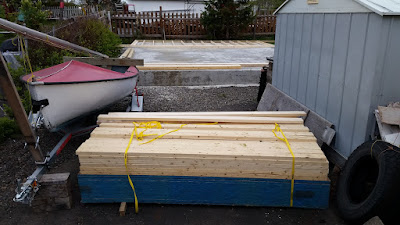As far as I can remember, my introduction to paddling was some canoeing at a summer camp as a kid in the 1970s at Mint Brook. I don't have strong memories of it, only that we were out at least once. After
that it was just a couple of short paddles with friends aboard their canoes as a teenager in the late 1970s and early 1980s.
My family had power boats and a summer cottage on Exploits Islands, so that is what I was most familiar with growing up. There was a rowboat out there, however, that I could use to make my way around the harbour, and I really enjoyed spending my summer days doing that.
Jumping ahead about 20 years to 2003 is when I bought a sea kayak. The Raid Avalon adventure races started that year, and kayaking was one of the disciplines, so I hunted around for one. What I ended up with was a yellow Wilderness Systems Tempest 170. This was a very nice touring kayak with a skeg, rather than a rudder.
 |
| Tempest 170 at Norris Arm North |
While I really liked the Tempest, finances were tight, so I traded it to Mike for his yellow Wilderness Systems Cape Horn 15 plus some cash. Mike had been on my "Last Minute Misfits" team for the first Raid Avalon. The money went toward my first set of cross-country skis for use in the winter edition of the race, which I did as a solo competitor.
 |
| I traded the Tempest 170 to Mike (above) for his Cape Horn 15. |
The Cape Horn 15 is very capable for its size, and I did a lot of paddling with it. I removed the rudder in favour of having more secure foot pegs, and it tracked well enough without it. The boat has been down the Exploits River, spent a weekend touring Badger Bay, been paddled all over the Bay of Exploits, including a weekend at Exploits Islands, as well as a couple of trips at Fogo Island.
From 1998 to now, my main form of water-based recreation has been sailing. Initially, I did a lot of sailing with other people, but by 2006 I was ready to buy my own, so I sold our 19' speedboat and the Cape Horn to help fund the purchase of a 22.6' 1977 AMF Paceship PY23. That boat we kept until the winter of 2020. It has its own blog at http://py23serenity.blogspot.com/.
Not being able to spend a lot of time out sailing for various reasons, we purchased a travel trailer to do some camping. To go along with that, in 2008 I bought my first canoe. It was a secondhand 14.5' Mad River St. Croix (now called the Explorer 14 TT). My sea kayaking training had been to Paddle Canada Intermediate and Flatwater Instructor (these designations have since changed) standards, and many of those skills translated over to canoeing. With a few YouTube videos to help fill in some gaps, I was well underway.
I feel more comfortable in a canoe than a sea kayak. It allows me to
move around and paddle from different positions. I'm on warmer water, so
just a few weeks into the season, I no longer require thermal
protection. To paddle safely on the bays and ocean surrounding Newfoundland, a good dry suit is required all year, but it can be used there too. A canoe has room for the dogs to come with me, as well as friends and grand kids. It is very versatile.
 |
| Paddling with Lucy on Woolfrey's Pond a few minutes from my house. |
Wilderness Systems Tempest 170
Manufacturer's Description:
Intentionally designed for paddlers of all sizes to take their sea kayaking prowess to the next level, the award-winning Tempest series delivers a signature performance like no other. The industry-leading comfort of the Phase 3® AirPro seating system combined with an unmatched capacity enables you to travel farther and achieve more, while the TruTrak adjustable skeg system allows you to seamlessly transfer from straight-tracking to supreme maneuverability.
Specifications:
Length: 17' / 518 cm
Width: 22" / 56 cm
Boat Weight: 57 lbs. / 26 kg
Boat Weight: 57 lbs. / 26 kg
Deck Height: 13.5" / 34 cm
Cockpit Length: 34" / 86 cm
Cockpit Length: 34" / 86 cm
Cockpit Width: 18" / 46 cm
Max Capacity: 325 lbs. / 147 kg
Max Capacity: 325 lbs. / 147 kg
Wilderness Systems Cape Horn 15
Specifications:
Length: 15' 5"
Width: 24"
Centre Depth: 13"
Weight: 62 lb.
Capacity: 250 lb.
2000 Mad River St. Croix
HIN: WKY139Z8F000
Manufacturer's Description:
Our most affordable recreation canoe, and one of our most capable. Featuring the classic Mad River Shallow V-Hull, the St. Croix makes a nice solo boat that can also carry the family. Although TripleTough™ construction means it`s slightly heavier than a Royalex® boat, it`s even more affordable, delivering true canoe performance in a versatile and seaworthy boat that`s easy to handle all the way around. Available with vinyl gunwales and web seats.
Specifications:
Length: 14' 6"
Width: 36"
Centre Depth: 14"
Weight: 69 lb. (rotomoulded)
Capacity: 850 lb. (6" freeboard)
Price: $599 US (vinyl trim)
(Source: https://www.myccr.com/gear/mad-river-st-croix)
HIN: WKY139Z8F000
Manufacturer's Description:
Our most affordable recreation canoe, and one of our most capable. Featuring the classic Mad River Shallow V-Hull, the St. Croix makes a nice solo boat that can also carry the family. Although TripleTough™ construction means it`s slightly heavier than a Royalex® boat, it`s even more affordable, delivering true canoe performance in a versatile and seaworthy boat that`s easy to handle all the way around. Available with vinyl gunwales and web seats.
Specifications:
Length: 14' 6"
Width: 36"
Centre Depth: 14"
Weight: 69 lb. (rotomoulded)
Capacity: 850 lb. (6" freeboard)
Price: $599 US (vinyl trim)
(Source: https://www.myccr.com/gear/mad-river-st-croix)
 |
| Put-in on Eel Brook heading to Big Eel Lake, 2021. |




























